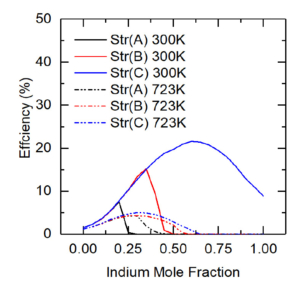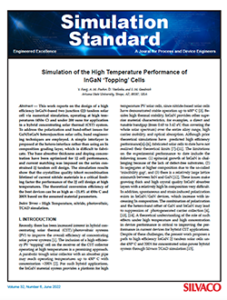Simulation of the High Temperature Performance of InGaN ‘Topping’ Cells
Y. Fang, A. M. Fischer, D. Vasileska, and S. M. Goodnick
Arizona State University, Tempe, AZ, 85287, USA
 Abstract — This work reports on the design of a high efficiency InGaN-based two junction (2J) tandem solar cell via numerical simulation, operating at high temperatures (450o C) and under 200 suns for application in a hybrid concentrating solar thermal (CST) system. To address the polarization and band-offset issues for GaN/InGaN heterojunction solar cells, band engineering techniques are employed. A simple interlayer is proposed at the hetero-interface rather than using an In composition grading layer, which is difficult to fabricate. The base absorber thickness and doping concentration have been optimized for 1J cell performance, and current matching was imposed on the series constrained 2J tandem cell design. The simulation results show that the crystalline quality (short recombination lifetime) of current nitride materials is a critical limiting factor the performance of the 2J cell design at high temperatures. The theoretical conversion efficiency of the best devices can be as high as ~21.8% at 450o C and 200X based on the assumed material parameters. Index Terms – High Temperature, nitride, photovoltaic, TCAD simulation.
Abstract — This work reports on the design of a high efficiency InGaN-based two junction (2J) tandem solar cell via numerical simulation, operating at high temperatures (450o C) and under 200 suns for application in a hybrid concentrating solar thermal (CST) system. To address the polarization and band-offset issues for GaN/InGaN heterojunction solar cells, band engineering techniques are employed. A simple interlayer is proposed at the hetero-interface rather than using an In composition grading layer, which is difficult to fabricate. The base absorber thickness and doping concentration have been optimized for 1J cell performance, and current matching was imposed on the series constrained 2J tandem cell design. The simulation results show that the crystalline quality (short recombination lifetime) of current nitride materials is a critical limiting factor the performance of the 2J cell design at high temperatures. The theoretical conversion efficiency of the best devices can be as high as ~21.8% at 450o C and 200X based on the assumed material parameters. Index Terms – High Temperature, nitride, photovoltaic, TCAD simulation.
Introduction
Recently, there has been increased interest in hybrid concentrating solar thermal (CST)/photovoltaic systems (PV) to improve the overall efficiency of concentrating solar power systems [1]. The inclusion of a high efficiency PV ‘topping’ cell on the receiver of the CST collector operating at high temperatures is a promising approach. A parabolic trough solar collector with an absorber pipe may reach operating temperatures up to 450° C with concentration ~200X [2]. For such hybrid applications, the InGaN material system provides a platform for high temperature PV solar cells, since nitride-based solar cells have demonstrated stable operation up to 600° C [3]. Besides high thermal stability, InGaN provides other superior material characteristics, for examples, a direct and tunable bandgap (from 0.65 to 3.42 eV, thus covering the whole solar spectrum) over the entire alloy range, high carrier mobility, and optical absorption. Although prior theoretical simulations have predicted high efficiency performance[4]–[6], fabricated solar cells to date have not realized their theoretical limits [7]–[11]. The limitations on the experimental performance to date include the following issues: (1) epitaxial growth of InGaN is challenging because of the lack of defect-free substrates, (2) In segregates at higher composition due to the so-called ‘miscibility gap’, and (3) there is a relatively large lattice mismatch between InN and GaN [12]. These issues make growing thick and high crystal quality InGaN absorber layers with a relatively high In composition very difficult. In addition, spontaneous and strain induced polarization exists in InGaN/GaN devices, which increase with increasing In composition. The combination of polarization and the hetero-band offset of GaN and InGaN may lead to suppression of photogenerated carrier collection [4], [13], [14]. A theoretical understanding of the role of such effects under high temperature and high concentration in device performance is critical to improving the performance in current devices for hybrid CST applications. Despite of these challenges, the present work proposes a path to high efficiency InGaN 2J tandem solar cells under 450° C and 200X for concentrated solar-power hybrid system through Silvaco TCAD simulation [15].



